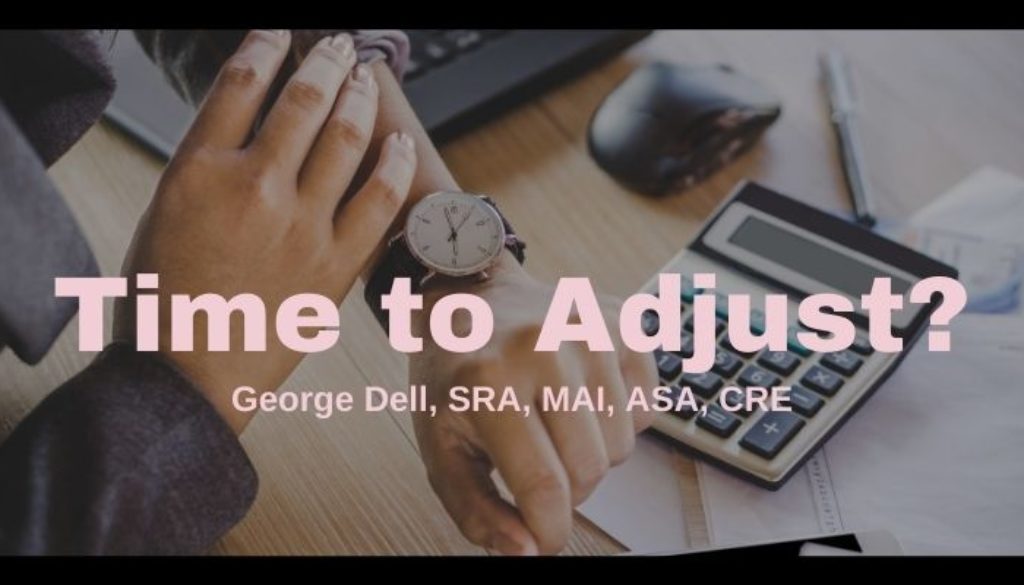Is it time that matters? Or is it different market conditions?
At one point, I was told to stop teaching that it’s a ‘time adjustment’. Because it’s actually a ‘market conditions’ adjustment. This bothered me. It seemed like yet another step backward in the march of appraisal practices.
Comparing market conditions at two different time-groups tends to mislead our thinking. Markets do not move in ‘clumps’ of conditions. Given a CMS© (Competitive Market Segment), it is a trend of price levels. Worse yet, the ‘clump’ thinking leads to clump analyses. Grouping presents a ‘common sense’ solution – that no good economist would ever consider. Statistics is often not intuitive. A prime example of “common sense” creation is the residential 1004MC form, which was (is) claimed to provide market analysis. The form seems common sense but requires uncommon skepticism.
The 1004MC clumps together groups of data, then compares the groups. “Grouped pair analysis” is described in the industry-dominant textbook. Problem. The grouped-pair solution for continuous variables (such as time) is the wrong model, the wrong algorithm, and produces ‘adjustments’ in the wrong amount, or even in the wrong direction!
In the early days of the Stats, Graphs, and Data Science classes, this algorithm was used as a prime example of bad statistics using ‘common-sense’ reasoning. It was and is misleading. Statisticians and economists call this fallacy “data discarding.”
Below is an excerpt from one of George Dell’s articles published in the Fall Issue of the Appraisal Journal, 2013.
Some of our residential appraisal students include this excerpt in their reports.
Common Statistical Errors and Mistakes: Valuation and Reliability.
For the full article, please go to The Appraisal Journal website or to EBSCOhost.
The underlying issue is that you, the appraiser was forced to use a bad model which produces nearly random results. Then pretend to certify that it was a good deal. Then spend time finding ways to work around it. The 1004MC alone — set back progress in modernizing appraisal using modern data and computer and visualization power.
So, what is wrong about using grouped-pair thinking for “market conditions” adjustments? The 1004MC (the bad model example) has these problems:
- Groups by date. (You discard the exact date and use a hypothetical mid-point date.)
- Groups irregularly. (6 months, 3 months, and 3 months.)
- Ignores relevance. (Later trend is much more important.)
- Excludes graphical representation (which points out irregularities and outliers.)
- Precludes the use of the right (two-variable) graph – the scatterplot!
So, what is the right way to ‘adjust’ for time?
- Use exact dates.
- Do not put in groups.
- Show scatter plot and trendlines.
- Regress using simple linear trend smoother.
- Identify trend changes with a third-order polynomial.
The main learning is modeling decisions, such as which algorithm solves which problem, and which type of graph best helps explore, describe, and predict.
In Stats, Graphs, and Data Science 1 class, we emphasize model decisions (kinda like ‘approaches’ to value), and how the do the mechanics of the appropriate algorithms – and how to provide short explanations for your readers.

May 13, 2021 @ 5:56 pm
Good article. Now if I could convince just 1 reviewer the regression analysis for time of sale is more relevant than the 1004mc.
May 14, 2021 @ 12:53 am
George Dell,
“One sale does not make the market”…, nor do 3 or 6. Based on your classes I have been using regression analysis graphs to assist in identifying market trends and value factors for at least the past ten years. Every appraisal I complete uses multiple data sets, each of which includes the subject type property in its location. These data sets comprise all the reasonably applicable market data that relates to a subject property’s value. The respective data sets search criteria range from broad based to narrowly defined. Regression analysis graphs with intelligently chosen data set search criteria are an essential real estate appraisal methodology. Thank you for your advocacy.